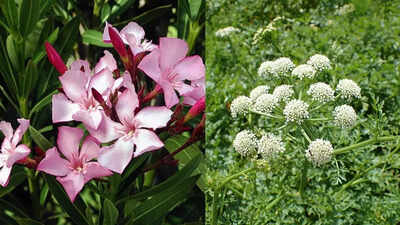ARTICLE AD BOX

Plants play a vital role in our environment by offering beauty, food and healing. However, some plants contain deadly toxins that can cause severe harm or even death to humans and animals.
These poisonous plants have evolved unique defenses to protect themselves from predators but they can be dangerous if touched or ingested. In this article, we will explore the 10 most poisonous plants in the world by revealing their toxic properties and the risks they pose. Understanding these plants is important for safety and awareness, especially for gardeners, hikers and anyone who spends time outdoors.
10 of the world’s deadliest plants
Deadly Nightshade (Atropa belladonna)
Deadly Nightshade, also known as Atropa belladonna, is one of the most toxic plants found in nature.
Native to Europe, North Africa and Western Asia, this plant contains powerful poisons called alkaloids which mainly contain atropine, scopolamine and hyoscyamine. These chemicals affect the nervous system and can cause symptoms like blurred vision, hallucinations, rapid heartbeat, seizures and even death if ingested in large amounts.
Its berries look tempting but are highly poisonous, especially to children.
Historically, belladonna was used in medicine and cosmetics but requires extreme caution due to its deadly nature. It’s a classic example of how beauty can hide danger.

Source: Wikipedia
Tobacco (Nicotiana tabacum)
Tobacco is widely known for its use in cigarettes and other products but it is also one of the most poisonous plants on Earth. The plant contains a powerful toxin called nicotine, which is highly addictive and harmful to humans and animals. Nicotine affects the nervous system and in large doses can cause symptoms like nausea, dizziness, seizures and even death.
While tobacco is legal and commonly used, its toxic effects make it dangerous especially when consumed excessively or by children and pets.
Tobacco’s deadly nature shows how some plants can be harmful despite their widespread use.

Source: Wikipedia
Manchineel (Hippomane mancinella)
Manchineel is considered one of the deadliest trees in the world. They are found mainly in the Caribbean, Florida and parts of Central and South America and every part of this tree is highly toxic.
Its sap contains strong toxins that can cause severe skin burns, blisters and eye injuries if touched. Even standing under the tree during rain can cause skin irritation because the water carries the toxins. Eating its small green fruit, often called beach apples, can be fatal.
Due to its extreme toxicity, locals often warn people to stay far away from the manchineel tree.

Source: Wikipedia
Lily-Of-The-Valley (Convallaria majalis)
Lily-of-the-Valley is a beautiful flowering plant known for its delicate white bell-shaped flowers and sweet fragrance.
Despite its charm, it is highly poisonous. All parts of the plant including the flowers, leaves, and berries IT contain toxic compounds called cardiac glycosides. These chemicals can affect the heart by causing symptoms like nausea, vomiting, irregular heartbeat and in severe cases even heart failure.
Even small amounts can be dangerous if ingested and because of its toxicity, Lily-of-the-Valley should be handled carefully and kept away from children and pets.

Source: Wikipedia
Oleander (Nerium oleander)
Oleander (Nerium oleander) is a popular ornamental shrub known for its beautiful flowers that come in pink, red, white or yellow. However, it is extremely poisonous. Every part of the plant including the leaves, flowers and stems contains toxic compounds called cardiac glycosides that can affect the heart. Ingesting even a small amount can cause symptoms like nausea, vomiting, abdominal pain, irregular heartbeat and in severe cases, death.
Because of its toxicity, oleander should never be eaten and should be handled with care, especially around children and pets.

Source: Wikipedia
Rosary Pea (Abrus precatorius)
Rosary Pea is a plant famous for its bright red seeds with a black spot, often used in jewelry. However, these seeds are highly poisonous because they contain a toxin called abrin. If the seeds are chewed or crushed and swallowed, the toxin can cause severe poisoning leading to symptoms like nausea, vomiting, diarrhea and even death.
The seeds are dangerous only if broken but swallowing whole seeds usually doesn’t cause harm.
Because of its deadly toxin, Rosary Pea should be handled with great care and kept away from children and pets.
Cerbera odollam
Cerbera odollam which is commonly known as the Suicide Tree is a highly toxic plant found in parts of Asia. Every part of the tree, especially its seeds contains deadly cardiac glycosides that can disrupt heart function.
Ingesting even a small amount can cause severe poisoning leading to symptoms like vomiting, irregular heartbeat, seizures and potentially death. Due to its extreme toxicity, Cerbera odollam has been historically associated with accidental and intentional poisonings.
It’s important to handle this plant with caution and keep it away from children and animals.

Source: Wikipedia
Hemlock water-dropwort (Oenanthe crocata)
Hemlock Water-Dropwort is one of the most poisonous plants found in Europe.
It grows in wet places like riverbanks and marshes and looks quite harmless with white umbrella-shaped flower clusters. However, all parts of this plant are extremely toxic due to a powerful poison called oenanthotoxin. Ingesting even a small amount can cause severe symptoms such as seizures, paralysis and respiratory failure which can be fatal if not treated quickly.
Because it closely resembles some edible plants, it’s important to be cautious when foraging near water.

Source: Wikipedia
Monkshood (Aconitum genus)
Monkshood, which is also known as Wolf’s Bane belongs to the Aconitum genus and is known for its beautiful hood-shaped blue or purple flowers. Despite its pretty appearance, all parts of the plant are highly toxic. It contains powerful toxins called aconitine that affect the heart and nervous system. Even small amounts can cause numbness, nausea, irregular heartbeat and in severe cases, death. Historically, it was used as poison on arrows.
Because of its extreme danger, Monkshood should never be touched or ingested without expert knowledge.

Source: Wikipedia
Thornapples (Datura genus)
Thornapples are highly poisonous plants containing toxic chemicals like atropine and scopolamine. These toxins affect the nervous system and can cause severe symptoms such as confusion, hallucinations, fast heartbeat, dry mouth and even death if ingested. All parts of the plant like flowers, leaves, seeds and stems are toxic. Due to their dangerous effects, Thornapples should be handled with extreme care and never consumed.

Source: Wikipedia
Also read: From Mandarinfish to Clownfish: These 8 fishes are so rare and beautiful



.png)
.png)
.png)
















 1 week ago
8
1 week ago
8









 English (US) ·
English (US) ·